- The district known as Sumer occupied the land between the Tigris and Euphrates River.
- Population increased due to new irrigation techniques.
- Cities and towns were founded, some with as many as 40,000 inhabitants.
- Better food storage allowed for diversity in profession: Priests, tradesmen, artisans, politicians, and farmers etc..
- Kings emerged as did family dynasties and the concept of the city-state.
- Sumerians invented the earliest form of writing, known as cuniform. (difference from pre-history and history)
- A pantheon of Sumerian Gods and Goddesses emerged with many of the deities representing the natural elements of the world.
- The worlds first (surviving) epic was the Sumerian "Epic of Gilgamesh" which told of a great flood.
- Sumerians first divided the hour of 60 minutes and the minute into 60 second; they also organized a calendar based on moon cycles.
- The ziggurat was a Sumerian temple built on top of a "mountain" of earth.
- A Mess o' Mesopotamia.
- Wandering nomads drove herds of domesticated animals in many areas, especially to the South of Sumer in Arabia.
- King Hammurabi of Babylon created a series of laws known as "Hammurabi's Codes" - laws that included "an eye for an eye" and regulations of marriage, divorce, and punishments for all sorts of crimes.
- The Expansion of Mesopotamian Civilization
- Indo-Europeans were people from the grasslands of the Russian Steppe who introduced the horse to the new East.
- The warlike Indo-European tribe known as the Hittites settled in Asia Minor.
- The Hittites had a lucrative trade in metals and conquered nearly all of their neighbors, even threatening Egypt.
When and where did human beings first emerge? - 200,000 years ago in Southwestern Africa.
Why did the period known as "prehistory" end? - When Sumerians invented the first form of writing known as cuniform.
What made the rise of civilization possible? - Increased ability to take care of young children. Also population increased to new irrigation techniques.
How did hunter/gatherers live? - They migrated to a lot of different places in search for food and other needs. Hunted, gathered, and fished for food.
Who was King Hammurabi, and why was he important? - King Hammurabi of Babylon created a series of laws known as "Hammurabi's Codes" - laws that included "an eye for an eye" and regulations of marriage, divorce, and punishments for all sorts of crimes.
- prehistory - The time before the invention of the written language.
- Paleolithic - =Old Stone Age.
- Neolithic Age - = New Stone Age
- Agricultural Revolution - The agricultural Revolution was a shift from itinerant hunting/gathering to more permanent settlements centered on agriculture (It began in Southwest Asia).
- Cuneiform - The earliest form of writing.
- Ziggurat - The ziggurat was a Sumerian temple built on top of a "mountain" of earth.
- Indo-Europeans - Indo-Europeans were people from the grasslands of the Russian Steppe who introduced the horse to the new East. The warlike Indo-European tribe known as the Hittites settled in Asia Minor. The Hittites had a lucrative trade in metals and conquered nearly all of their neighbors, even threatening Egypt

No comments:
Post a Comment